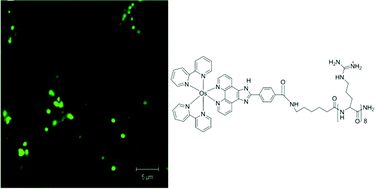Osmium(ii) polypyridyl polyarginine conjugate as a probe for live cell imaging; a comparison of uptake, localization and cytotoxicity with its ruthenium(ii) analogue†
Abstract
A first investigation into the application of a luminescent osmium(II) bipyridine complex to live cell imaging is presented. Osmium(II) (bis-2,2-bipyridyl)-2(4-carboxylphenyl) imidazo[4,5f][1,10]phenanthroline was prepared and conjugated to octaarginine, a cell penetrating peptide. The photophysics, cell uptake and cytotoxicity of this osmium complex conjugate were performed and compared with its ruthenium analogue. Cell uptake and distribution of both ruthenium and osmium conjugates were very similar with rapid transmembrane transport of the osmium probe (complete within approx. 20 min) and dispersion throughout the cytoplasm and organelles. The near-infrared (NIR) emission of the osmium complex (λmax 726 nm) coincides well with the biological optical window and this facilitated luminescent and luminescence lifetime imaging of the cell which was well resolved from cell autofluorescence. The large Stokes shift of the emission also permitted resonance Raman mapping of the dye within CHO cells. Rather surprisingly, the osmium conjugate exhibited very low cytotoxicity when incubated both in the dark and under visible irradiation. This was attributed to the remarkable stability of this complex which was reflected by the complete absence of photo-bleaching of the complex even under extended continuous irradiation. In addition, when compared to its ruthenium analogue its luminescence was short-lived in water therefore rendering it insensitive to O2.


 Please wait while we load your content...
Please wait while we load your content...